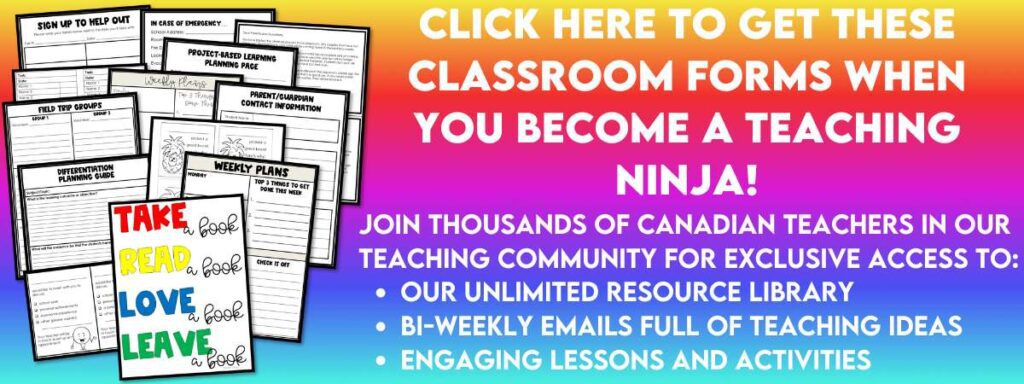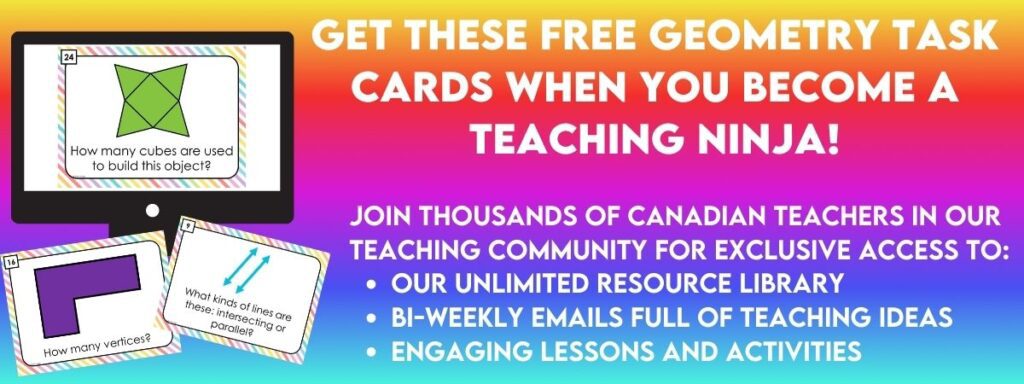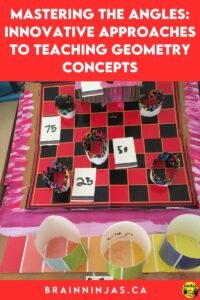
When we start talking about quadrilaterals, trapezoids, and parallel lines, many students get lost quickly. There are so many new and uncommon words introduced in our geometry concepts unit and it is especially difficult for English Language Learners. These are some of the ways we build an understanding of shape and space concepts in our classroom.
Geometry is Full of Vocabulary
When we talk about shape and space, we mean the different types of two-dimensional shapes and three-dimensional objects and how they relate to each other. This includes the different characteristics or attributes of each. With so many words that are not used in daily conversation, we use a variety of ways to include vocabulary.
Teach Geometry Vocabulary Directly
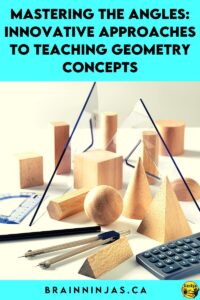
Some geometry concepts require direct instruction, and this is a unit that we tend to teach first and then explore later so that students have the language as they practice.
We use interactive math units in our classroom. To read more about how we use them, check out this post: How to Change Math With Interactive Notebooks. Our notebook units contain everything you would need to teach, practice and assess each concept from the shape and space unit.
Use Interactive Math Units
Our units come with complete lesson plans for the teachers and all the student pages. These pages include templates where students will make a reference book of all the concepts you teach. We have one version that requires cutting and pasting but another where you can just print and write. We’ve also included worksheets, games, activities and assessments so you can just teach, practise, review and assess without searching everywhere for all your materials.
Geometry Concepts Interactive Math Unit for Grade 3
It includes everything you need to teach concepts for sides, vertices, polygons, quadrilaterals and much more. It can be found on TpT ($USD) and our BN Shop ($CAN). The Interactive Math Unit Full Year Bundle for Grade 3 can be found on TpT ($USD) and our BN Shop ($CAN).
Geometry Concepts Interactive Math Unit for Grade 4
It includes types of lines, congruency, symmetry, 2D shapes, 3D objects, nets, and transformations. It can be found on TpT ($USD) and our BN Shop ($CAN). The Interactive Math Unit Full Year Bundle for Grade 4 on TpT ($USD) and our BN Shop ($CAN).
Geometry Concepts Interactive Math Unit for Grades 4/5
It includes types of lines, congruency, symmetry, 2D shapes, 3D objects, nets, the Cartesian Plane and transformations. It can be found on TpT ($USD) and our BN Shop ($CAN). The Interactive Math Unit Full Year Bundle for Grade 4/5 on TpT ($USD) and our BN Shop ($CAN).
Geometry Concepts Interactive Math Unit for Grade 5
It includes types of lines, congruency, symmetry, 2D shapes, 3D objects, nets, the Cartesian Plane and transformations. It can be found on TpT ($USD) and our BN Shop ($CAN). The Interactive Math Unit Full Year Bundle for Grade 5 on TpT ($USD) and our BN Shop ($CAN).
Geometry Concepts Interactive Math Unit for Grades 5/6
It includes lines, congruency, symmetry, types of triangles, polygons, quadrilaterals, making nets, translations, reflections, rotations, ordered pairs, coordinates, and the Cartesian Plane. It can be found on TpT ($USD) and our BN Shop ($CAN). The Interactive Math Unit Full Year Bundle for Grades 5/6 on TpT ($USD) and our BN Shop ($CAN).
Geometry Concepts Interactive Math Unit for Grade 6
It includes congruency, symmetry, types of triangles, translations, reflections, rotations, ordered pairs, coordinates, and the Cartesian Plane. It can be found on TpT ($USD) and our BN Shop ($CAN). The Interactive Math Unit Full Year Bundle for Grade 6 on TpT ($USD) and our BN Shop ($CAN).
Build a Shape and Space Arcade
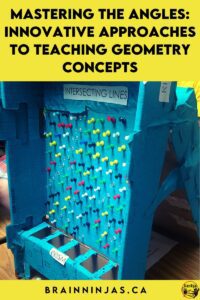
What could be more fun than using everything you’ve learned in the geometry concepts unit to create a cardboard cafe? We were inspired by Caine’s Arcade to have our students make their own arcade games. Before the pandemic, we would have invited students from other classes to play the games, but this is a great activity, no matter what.
This project is messy and takes time, but the payoff is huge and the engagement is off the charts.
Start by watching the video with your students. Talk about the different types of arcade-style games that students could make. Brainstorm possibilities. Over the years, our students have created so many different styles of games. Sometimes, they are inspired by shows like The Price is Right, and other times, they are inspired more by carnival-style games.
Once students know what they want to create, they get to work planning out the materials they will need. In the weeks leading up to build day, students bring in lots of recyclable materials like cereal boxes, containers, cardboard boxes, paper tubes, and so much more. We use materials from our makerspace.
Some materials go in the general build pile, which means on build day, they are available to all the students. More special or specific materials that will belong to a student are labelled and stored away from the general pile. We stock up on masking tape, hot glue and paint (don’t worry, we don’t paint on build day).
If Project-Based Learning is new to you, you should read our post: The Reasons for Project-Based Learning. We also have a checklist that you can find in our Resource Library, or we can send it to you when you join our mailing list.
Build Day
On build day, we clear space in the classroom, and we talk about how we will use the materials to build what we have planned. Students make their creations, problem-solve, and test out their games. We use the Design Process all day long.
We say that we build all day, but we still attend gym, music or library classes along with recess and lunch breaks. Generally, students are able to build their projects in one day, and this means we don’t have to get everything out and clean up over and over again. We let our custodians know what we’re up to and give them the day off from cleaning our room.
When the students are done building, they help clean up and organize the leftover materials. They clean up the classroom, and we store the projects along one side of the room. We respect each other’s work by not touching or playing with the parts without asking first.
Painting Day
This is another messy day, but doing all the painting in one sitting makes it easier. We put down tablecloths to keep paint off the floor. Students use liquid Tempera because it tends to cover well and dries quickly.
We do one coat, take a quick break and then come back to do the finishing touches. Clean-up is a breeze because our students are used to our clean-up routine. You can read more about that here.
Play Day
Students get the chance to show off their creations. This is where the demonstration of learning comes in. Students are quizzed to show the attributes of their builds. What shapes or objects are included? What types of lines, number of edges, or faces does their game include?
Students present their games to the class and show all the different attributes it has.
Once the presentations are done, we invite other classes of students to come to play in our arcade. It’s so much fun!
Worksheets and Worksheet Games
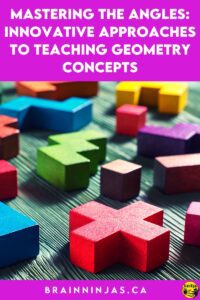
While worksheets are not glamorous, they do serve a purpose. We use worksheets in lots of different ways. You can read more about how we use them in our post Worksheet Games Your Students Will Love.
Our interactive math unit sets come with practice pages included, but these sets are unique questions. All of our worksheet sets come with answer keys.
The grade levels are approximate and might vary slightly depending on the outcomes for your region.
Grade 3
2D Shapes and Polygons Grade 3-4 – Find on TpT ($USD) or our BN Shop ($CAN)
3D Objects Names Grade 3 – Find on TpT ($USD) or our BN Shop ($CAN)
Nets of 3D Objects Grade 3 – Find on TpT ($USD) or our BN Shop ($CAN)
3D Objects Attributes Grade 3 – Find on TpT ($USD) or our BN Shop ($CAN)
Quadrilaterals Introduction Grade 3-4 – Find on TpT ($USD) or our BN Shop ($CAN)
Transformations of Polygons Grade 3 – Find on TpT ($USD) or our BN Shop ($CAN)
Grade 4
2D Shapes and Polygons Grade 4 – Find on TpT ($USD) or our BN Shop ($CAN)
2D Shapes and Polygons Grade 3-4 – Find on TpT ($USD) or our BN Shop ($CAN)
3D Objects Names Grade 4 – Find on TpT ($USD) or our BN Shop ($CAN)
3D Objects Attributes Grade 4 – Find on TpT ($USD) or our BN Shop ($CAN)
Symmetry of 2D Shapes Grade 4 – Find on TpT ($USD) or our BN Shop ($CAN)
Congruency of 2D Shapes Grade 4-6 – Find on TpT ($USD) or our BN Shop ($CAN)
Naming Polygons or 2D Shapes by Attribute Grade 4 – Find on TpT ($USD) or our BN Shop ($CAN)
Types of Lines Grade 4 – Find on TpT ($USD) or our BN Shop ($CAN)
Types of Triangles Introduction Grade 4 – Find on TpT ($USD) or our BN Shop ($CAN)
Quadrilaterals Introduction Grade 3-4 – Find on TpT ($USD) or our BN Shop ($CAN)
Quadrilaterals Attributes Grade 4-5 – Find on TpT ($USD) or our BN Shop ($CAN)
Transformations of 2D Shapes Grade 4 – Find on TpT ($USD) or our BN Shop ($CAN)
Nets of Prisms and Pyramids Grade 4-5 – Find on TpT ($USD) or our BN Shop ($CAN)
Grade 5
3D Objects Names and Attributes Grade 5 – Find on TpT ($USD) or our BN Shop ($CAN)
Cartesian Plane Plotting Coordinates Grade 5-6 – Find on TpT ($USD) or our BN Shop ($CAN)
Names and Attributes of Polygons or 2D Shapes Grade 5 – Find on TpT ($USD) or our BN Shop ($CAN)
Nets of Prisms and Pyramids Grade 4-5 – Find on TpT ($USD) or our BN Shop ($CAN)
Quadrilaterals Attributes Grade 4-5 – Find on TpT ($USD) or our BN Shop ($CAN)
Reflection Symmetry Grade 5 – Find on TpT ($USD) or our BN Shop ($CAN)
Rotational Symmetry Grade 5 – Find on TpT ($USD) or our BN Shop ($CAN)
Grade 6
Cartesian Plane Plotting Coordinates Grade 5-6 – Find on TpT ($USD) or our BN Shop ($CAN)
Cartesian Plane Using Coordinates Grade 6 – Find on TpT ($USD) or our BN Shop ($CAN)
Complex Transformations Double Event Grade 6 – Find on TpT ($USD) or our BN Shop ($CAN)
Congruency of 2D Shapes Grade 4-6 – Find on TpT ($USD) or our BN Shop ($CAN)
Tessellations Grade 6 – Find on TpT ($USD) or our BN Shop ($CAN)
Types of Triangles Attributes Grade 6 – Find on TpT ($USD) or our BN Shop ($CAN)
Classifying Triangles by Measuring Grade 6 – Find on TpT ($USD) or our BN Shop ($CAN)
We also have bundles for each province containing worksheets that align with each province’s curriculum:
Alberta-Aligned:
- Grade 3 Geometry Bundle – Find on TpT ($USD) or our BN Shop ($CAN)
- Grade 4 Geometry Bundle – Find on TpT ($USD) or our BN Shop ($CAN)
- Grade 5 Geometry Bundle – Find on TpT ($USD) or our BN Shop ($CAN)
- Grade 6 Geometry Bundle – Find on TpT ($USD) or our BN Shop ($CAN)
BC-Aligned:
- Grade 3 Geometry Bundle – Find on TpT ($USD) or our BN Shop ($CAN)
- Grade 4 Geometry Bundle – Find on TpT ($USD) or our BN Shop ($CAN)
- Grade 5 Geometry Bundle – Find on TpT ($USD) or our BN Shop ($CAN)
- Grade 6 Geometry Bundle – Find on TpT ($USD) or our BN Shop ($CAN)
Saskatchewan-Aligned:
- Grade 3 Geometry Bundle – Find on TpT ($USD) or our BN Shop ($CAN)
- Grade 4 Geometry Bundle – Find on TpT ($USD) or our BN Shop ($CAN)
- Grade 5 Geometry Bundle – Find on TpT ($USD) or our BN Shop ($CAN)
- Grade 6 Geometry Bundle – Find on TpT ($USD) or our BN Shop ($CAN)
Task Cards
Task cards are one of our favourite ways to practice concepts. Some people feel that printing and cutting out task cards is a lot of work, but we’ve overcome some of those challenges. You can read more about that in our post: The Trouble With Task Cards and How to Fix It.
All of our task card sets come with three decks, each with twenty-four questions. That means when you buy one set, you get seventy-two questions. Additionally, each set comes in three formats: paper, Google Slides and Google Forms (the forms are self-grading).
Symmetry of 2D Shapes Grades 4/5 – Find on TpT ($USD) or our BN Shop($CAN)
Transformations of 2D Shapes Grades 5-6 – Find on TpT ($USD) or our BN Shop ($CAN)
Polygons and 2D Shapes Grades 4/5 – Find on TpT ($USD) or our BN Shop ($USD)
3D Objects (Names and Attributes) Grades 4/5 – Find on TpT ($USD) or our BN Shop ($CAN)
Nets of 3D Objects Grades 4/5 – Find on TpT ($USD) or our BN Shop ($CAN)
Types of Lines Grades 4/5 – Find on TpT ($USD) or our BN Shop ($CAN)
Would you like to try a set for free? We made a special shape and space deck just for our ninjas! You can grab the deck by signing up for our email list. We’ll mail it directly to you, or you can find it in our Resource Library.
Label the Vocabulary in the Real World
Name the different characteristics in your classroom so they are visual. Have students find edges, vertices or faces on objects around your room. Use a set of sticky notes and have students find different elements. Students love labelling all the things. You could even make more permanent labels by typing and printing them out.
Create Diagrams and Anchor Charts
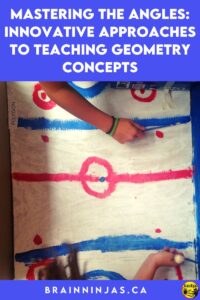
Students love using smelly markers and big pieces of chart paper. Involve them in making these charts and hang them prominently around the classroom. Geometry concepts are very visual, so they make great anchor charts.
Sometimes, we will pick a concept from the unit and have students create a chart to teach the rest of the class. Other times, we use anchor charts after we’ve taught the concepts to round them up for review.
Put the information needed for the posters up in one place or let students use their math notebooks so they put the correct information on the posters. Explain that posters will be assessed on their accuracy but encourage creativity as well.
When students create the anchor charts themselves, they are more likely to connect to information. And frankly, when students create the anchor charts, it saves you time and money making them yourself.
What About Other Math Concepts?
We love teaching math, which is odd because it was usually one of the most difficult subjects when we were in school. Your love (or lack of love) will rub off on your students, so let us help you.
These math posts might be helpful to you:
- How to Use Interactive Notebooks to Teach Number Sense
- Conquer Math With These Proven Multiplication Strategies
- How to Change Math With Interactive Notebooks
- How to Teach Students to Analyze Errors in Math
- Ways to Bring Graphing Activities into Your Classroom Daily
- How to Help Your Students Master Decimal Operations
- How to Add Candy to Your Math Lessons
- Ways to Successfully Teach Long Division
- How to Make Teaching Patterns Painless
- Ways to Teach Classifying Triangles
- How to Teach Rounding Numbers
What are some of the other ways you encourage reviewing the vocabulary from a geometry unit? How are you teaching geometry concepts? Tell us about it in the comments below.

